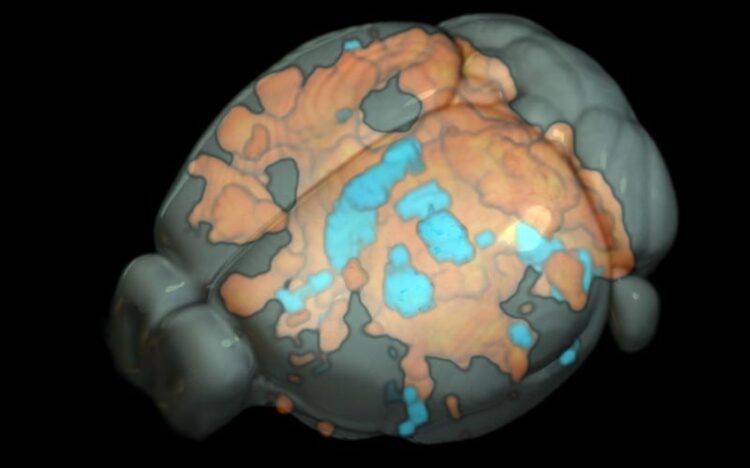New technology may help inform brain stimulation

Mouse brain activity under optogenetic stimulation detected by ultrafast fMRI technique. Red shows a positive response (reflecting excitatory activity) and blue shows a negative response (reflecting inhibitory activity).
Credit: Associate Professor Kai-Hsiang Chuang / Queensland Brain Institute
Brain stimulation, such as Deep brain stimulation (DBS), is a powerful way to treat neurological and psychiatric disorders. While it has provided therapeutic benefit for sufferers of Parkinson’s, Alzheimer’s, and addiction for more than a decade, its underlying neural mechanism is not yet fully understood.
Researchers at the Queensland Brain Institute (QBI) are now one step closer to unravelling the mystery of brain activity to better understand this mechanism and potentially predict DBS outcomes.
The brain is a highly complex network of circuits organised hierarchically with wide-ranging connections. Connections go in different directions, forwards and backwards, and between neurons that are either excitatory – the accelerators of a response – or inhibitory – the brakes modifying a response.
“Say you want to move your hand – once that signal is initiated, we expect that the activity that follows depends on the brain’s neural networks,” Associate Professor Kai-Hsiang Chuang said.
“What we don’t fully understand is how or when these structural and functional components of the brain interact to eventually lead to the outcome of moving your hand.”
Functional MRI (fMRI) is the most popular technique used to study brain networks. fMRI tracks blood flow and oxygenation changes following neural activity, thereby indirectly measuring the functional connections being formed, and giving us an indication of where brain activity is propagating.
Brain activity, however, isn’t as simple as a signal travelling from area to area.
The team at the Chuang laboratory have developed a new ultrafast fMRI technique with a vastly increased temporal resolution, enabling them to capture the dynamics of brain activity at a sub-second level.
Associate Professor Chuang said the new technique had led to more comprehensive understanding of how and when the brain’s structural and functional connections interact.
“The first new discovery we made is that brain activity not only propagates through structural wiring but follows certain preferential circuits depending on their excitatory and inhibitory neuronal distribution,” he said.
“Communication between brain regions of similar cell types becomes more fluent, and the brain activity stronger.”
The Chuang group tracked the brain activity of mice both while stimulated and at rest using their ultrafast fMRI technique. When the brain was stimulated, activity followed the structural wiring in the forward direction — from A to B and then B to C. When the brain was at rest, activity was more dependent on cell type organisation and less on structural wiring, propagating between C and B but not with A, if that’s where the preferential circuit was.
This means that how information is processed is actually dependent on your state, where it was previously thought that brain activity functioned in the same way whether at rest or busy doing a task.
“The second discovery we made was that the blood signal detected by fMRI could reflect the network organisation and cell type distribution,” Associate Professor Chuang said.
“These findings have significant implications for how brain structure shapes function, and how to predict activity based on the knowledge of this structure. More practically, what we now know will impact the design of DBS and other brain stimulation techniques.
“The next steps are to work with clinicians versed in brain stimulation to determine how we can utilise this knowledge combined with human data to help improve our understanding of DBS.”
This more comprehensive understanding could enable us to better predict DBS results and potentially improve its design for better therapeutic outcomes.
This study was first published in the Proceedings of the National Academy of Sciences (PNAS).
Media: Queensland Brain Institute, Merrett Pye, merrett.pye@uq.edu.au, +61 (0)422 096 049 or Elaine Pye, e.pye@uq.edu.au, +61 (0)415 222 606.
Image caption: mouse brain activity under optogenetic stimulation detected by ultrafast fMRI technique. Red shows a positive response (reflecting excitatory activity) and blue shows a negative response (reflecting inhibitory activity).
Journal: Proceedings of the National Academy of Sciences
DOI: 10.1073/pnas.2202435120
Method of Research: Experimental study
Subject of Research: Animals
Article Title: Hemodynamic transient and functional connectivity follow structural connectivity and cell type over the brain hierarchy
Article Publication Date: 24-Jan-2023
All latest news from the category: Medical Engineering
The development of medical equipment, products and technical procedures is characterized by high research and development costs in a variety of fields related to the study of human medicine.
innovations-report provides informative and stimulating reports and articles on topics ranging from imaging processes, cell and tissue techniques, optical techniques, implants, orthopedic aids, clinical and medical office equipment, dialysis systems and x-ray/radiation monitoring devices to endoscopy, ultrasound, surgical techniques, and dental materials.
Newest articles

A universal framework for spatial biology
SpatialData is a freely accessible tool to unify and integrate data from different omics technologies accounting for spatial information, which can provide holistic insights into health and disease. Biological processes…

How complex biological processes arise
A $20 million grant from the U.S. National Science Foundation (NSF) will support the establishment and operation of the National Synthesis Center for Emergence in the Molecular and Cellular Sciences (NCEMS) at…

Airborne single-photon lidar system achieves high-resolution 3D imaging
Compact, low-power system opens doors for photon-efficient drone and satellite-based environmental monitoring and mapping. Researchers have developed a compact and lightweight single-photon airborne lidar system that can acquire high-resolution 3D…





















